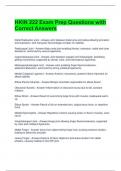HKIN 222 Exam Prep Questions with
Correct Answers
Distal Radioulnar Joint - Answer-Joint between distal ulna and radius allowing pronation
and supination, with triangular fibrocartilage complex for stability.
Radiocarpal Joint - Answer-Major wrist joint enabling flexion, extension, radial and ulnar
deviations, reinforced by various ligaments.
Carpometacarpal Joint - Answer-Joint between carpals and metacarpals, facilitating
gliding movements, supported by dorsal, volar, and interosseous ligaments.
Metacarpophalangeal Joint - Answer-Joint enabling finger flexion/extension,
adduction/abduction, reinforced by strong collateral ligaments.
Medial Collateral Ligament - Answer-Anterior, transverse, posterior fibers important for
elbow stability
Elbow Flexion Muscles - Answer-Biceps, brachialis responsible for elbow flexion
Olecranon Bursitis - Answer-Inflammation of olecranon bursa due to fall, constant
irritation
Elbow Strain - Answer-Result of overcoming large force with muscle, inadequate warm-
up
Elbow Sprain - Answer-Result of fall on extended arm, valgus/varus force, or repetitive
force
Medial Epicondylitis - Answer-Repetitive motions causing strain on flexor muscles, ulnar
nerve
Interphalangeal Joint - Answer-Hinge joint allowing finger flexion/extension, supported
by volar and collateral ligaments.
Mallet Finger - Answer-Injury from object hitting finger end, avulsing extensor tendon,
leading to deformity and pain.
Jersey Finger - Answer-Rupture of flexor digitorum profundus tendon from distal
phalanx, causing inability to flex DIP joint.
, Boutonniere Deformity - Answer-Result of blunt trauma to PIP joint, causing
hyperextension at MCP joint, flexion at PIP joint, and hyperextension at DIP joint.
Ganglion Cysts - Answer-Benign tumor masses on wrist's dorsal aspect, associated
with tissue sheath degeneration, often palpable between extensor tendons.
Metacarpal Fractures - Answer-Fractures causing severe pain, dorsal swelling, and
deformity, with specific types like Bennett's and Boxer's fractures.
Subungual Hematoma - Answer-Result of direct trauma to nail bed, leading to trapped
blood under fingernail, requiring drainage to relieve pressure.
Scaphoid Fracture - Answer-Most common carpal fracture, often due to hyperextension
during fall, causing pain in anatomical snuff box and wrist extension.
Shoulder Complex Mobility - Answer-Allows extreme mobility but little stability, prone to
injury
Sports-related Shoulder Injuries - Answer-Involved in 8-13% of sports injuries, common
in overhead activities
Glenoid Labrum - Answer-Narrow fibrocartilage rim deepening the glenoid fossa
Rotator Cuff Muscles - Answer-Supraspinatus, Infraspinatus, Teres minor,
Subscapularis
Shoulder Dislocation Symptoms - Answer-Intense pain, tingling, numbness, held in
slight abduction
AC Sprain - Answer-Weak AC joint, common in sports, Rx involves NSAIDs,
immobilization
Impingement Syndrome - Answer-Chronic condition from overhead activity damaging
shoulder tissues
Rotator Cuff Tendinitis - Answer-Result of repetitive microtraumas, may lead to
impingement
Clavicular Fractures - Answer-Highly susceptible to compressive forces, Rx with figure 8
brace
Bicipital Tendon Injuries - Answer-Common in overhead movements, pain over bicipital
groove
Elbow Dislocation Symptoms - Answer-Severe pain, cracking, swelling, obvious
deformity, inability to move




